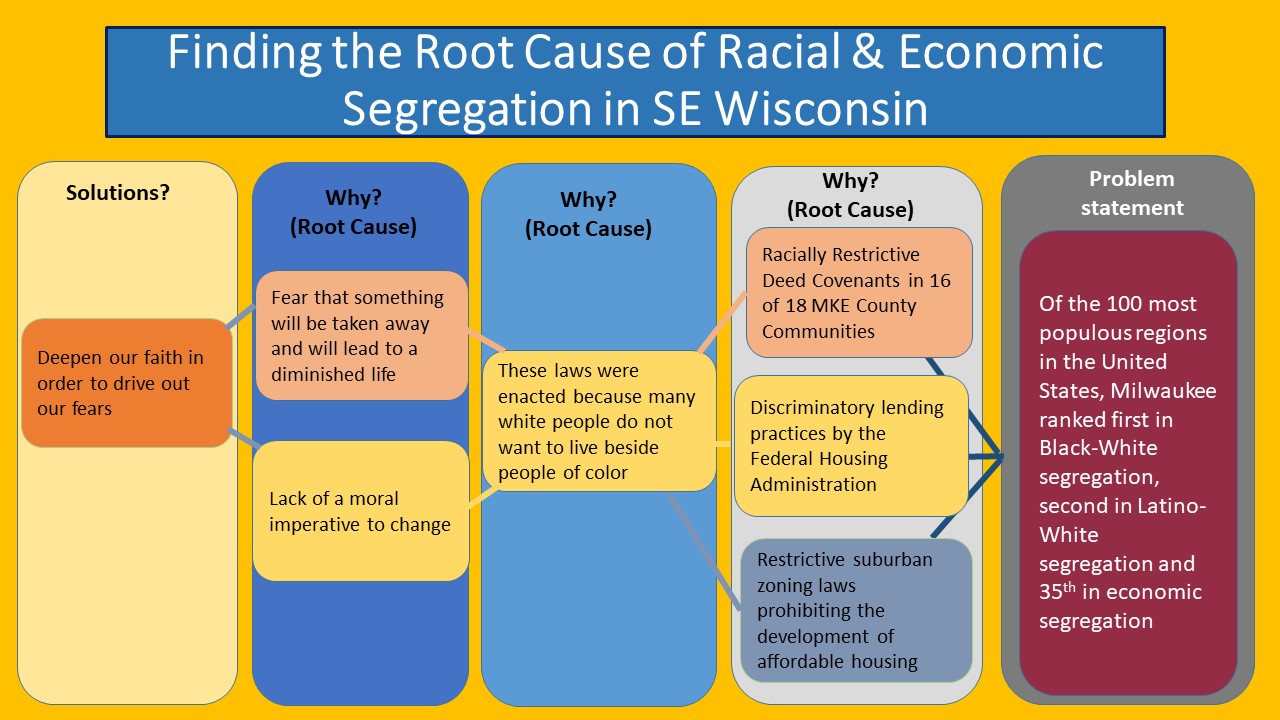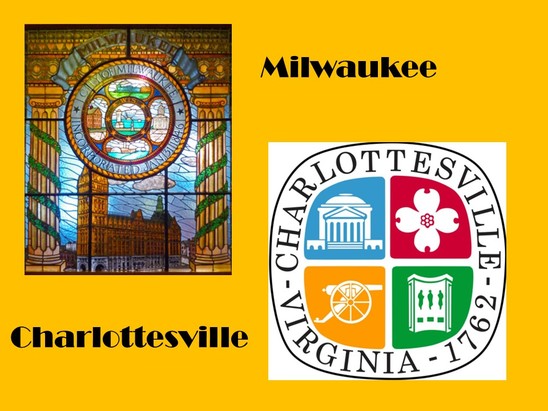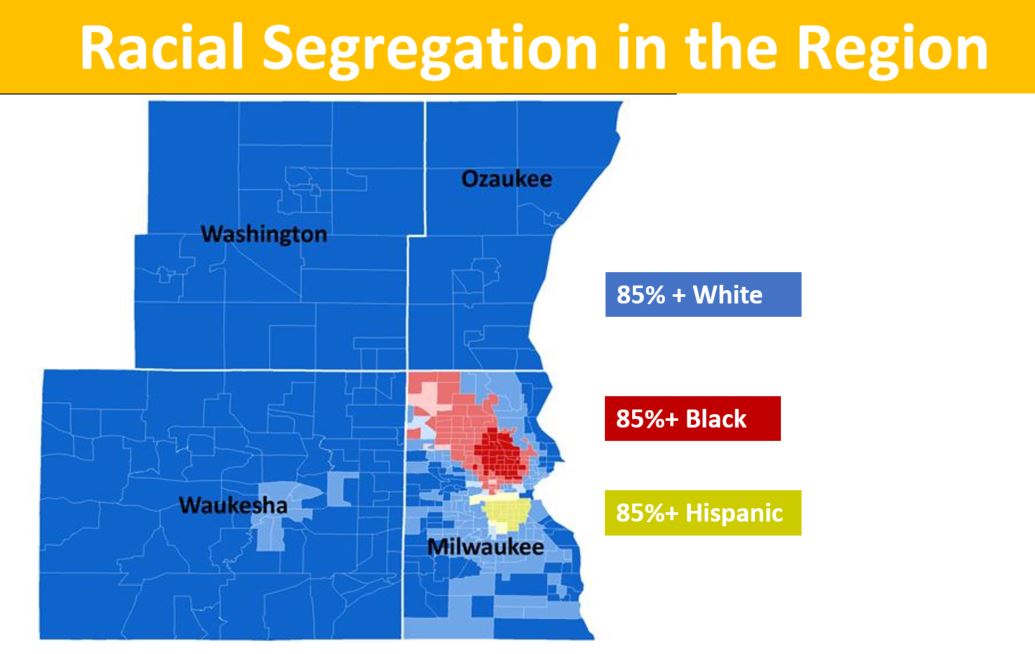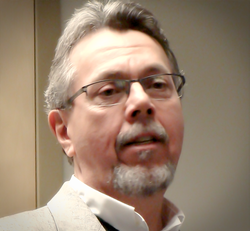Many white people don’t want to live beside people of color. When said this directly it seems obvious. A community does not create laws and erect barriers with the express purpose of keeping people out unless they just don’t want to live next to them. What is the root cause of the racial and economic segregation in southeastern Wisconsin?
In the world of process improvement, there is a tool used by practitioners to identify the “root cause” of a problem. The tool is called the “5 Why” exercise. To do this you basically define a problem and then ask “Why” five or so times until you identify the core element driving the issue. I use this 5 Why exercise in my work when helping communities understand the root cause of the issues they face such as an increase in child protective service actions or lackluster reading scores. I thought it would be helpful to apply this tool to the problem of racial and economic segregation in southeastern Wisconsin. A picture of the completed exercise is provided at the head of this article. The first step of this exercise is to clearly and factually define the problem. The problem statement I used is this: “Of the 100 most populous regions in the United States, Milwaukee ranked first in Black-White segregation, second in Latino-White segregation and 35th in economic segregation.” The next step is to ask “Why”? Why does Milwaukee rank so high among the 100 most populous regions of the country? I came up with three reasons for the ranking:
From my perspective, the answer is the same for all three: Many white people do not want to live beside people of color in southeastern Wisconsin. And now the hard question: Why do so many white people not want to live beside people of color in southeastern Wisconsin? Before I answer that question from my perspective I am compelled to provide a few caveats. First, this is not a condemnation of all white people. And it certainly isn’t an attempt to create a sense of guilt or to point the finger of blame. All I am trying to do is take a hard and honest look at the root cause of discrimination in southeastern Wisconsin. When I search my heart, I cannot identify any core reason for the restrictive laws other than what I have stated: Many white people don’t want to live beside people of color. When said this directly it seems obvious. A community does not create laws and erect barriers with the express purpose of keeping people out unless they just don’t want to live next to them. If we aspire to be one community, then eventually we must answer this critical question: What is the root cause for why white people don’t want to live beside people of color in our region? I can come up with two reasons. First, I think people are afraid. They believe that something will be taken away from them and some part of their life will be diminished if they live and raise their children in a racially and economically integrated environment. Second, there is no real sense of a moral imperative. The fear people feel overrides any faith dictate to “love my neighbor as myself” or to put faith into action. In 1957 when Dr. Martin Luther King founded the Southern Christian Leadership Conference, he did so with the stated purpose of working to save the soul of America. That was King’s analysis of the solution to racial and economic discrimination sixty years ago, and I believe it is the same today. The soul of America is crippled with fear and the faith of America is held hostage to that fear. That, I believe is the root cause of discrimination and segregation in southeastern Wisconsin. We allow our fear to quiet the leadings of our better angels. The answer I believe, is to delve deeply into the teachings of our faith traditions. There, we will find a mandate to love our neighbor as ourselves, said in a myriad of ways by a wide variety of spiritual leaders. When we renew our faith, we will have quelled our fears. When we renew our faith, we will have healed our souls and in the process, we will have healed the soul of America.
0 Comments
In Milwaukee and in southeastern Wisconsin, we are on the front lines of the battle against racism whether we acknowledge it or not. My social network feed is breaking over the weekend incidents in Charlottesville. So is my heart. Many have spoken out against the racism inherent in the alt-right march that sparked the violence, and rightfully so. Racism, hate, murder and violence cannot be tolerated. But the unfortunate fact is that all too often, it is tolerated now and has been tolerated in America’s past. Here is a sad litany of some of our racist actions as a people:
It seems easy to condemn the actions of our country in the past. It seems equally easy to sit at our computers and denounce the racists marchers in Virginia from our vantage point of living in the Midwest hundreds of miles from the “front lines”. But, here in Milwaukee and in southeastern Wisconsin, we are on the front lines of the battle against racism whether we acknowledge it or not. The Milwaukee Journal Sentinel recently published a series of articles looking at the similarities between the conditions fermenting the open housing marches in 1967 and those that sparked the unrest in Sherman Park in 2016, nearly fifty years later. Unfortunately, not much has changed and in many instances things have gotten worse. Poverty has deepened, incarceration rates have increased, unemployment of Black males is in double digits and the gaps in education between minority students and white students persist. I have a challenge to all people of good will who want to stand up in opposition to what has transpired in Charlottesville recently and it is this: spend your time and energy working to alleviate the structural racism in southeastern Wisconsin instead. The racism here is much more insidious. We don’t have the easily identifiable evil of Nazis and white supremacists marching in the streets. What we do have is institutional racism hidden behind the doors of civility and carried out in dry and long-standing public policies. We have 72% of all poor people in the four-county region packed into the city of Milwaukee, with little support or affordable housing elsewhere. We have cynical politicians opposing mass transit in the suburbs and suppressing voter registration in predominantly minority communities. Segregation is an evil that must be confronted by all people of faith and good will. We are willing to do so when the evil is far away – in Charlottesville. But it takes a special kind of strength and courage to confront the segregation in our own back yard. When we search our hearts, perhaps we will understand that inaction on this home-grown segregation is tacit approval of its continuation. The Racial and Economic Segregation of the Region is the Number One Social Justice Issue of Our Time.
I believe that the racial and economic segregation of southeastern Wisconsin is the number one social justice issue that we face today. All other issues in the region such as unemployment, education, police-community relations, housing - stem from the long-term impact of the racial dynamics of the region.
I am working with the Interfaith Conference of Greater Milwaukee to create a response from the faith community to this issue. I will be writing more about this effort as it kicks off in the fall of 2017. Here are three questions we can be asking ourselves as we ponder this issue: 1. Why has there been little substantive change in racial and economic segregation in the region? 2. What will move the hearts and minds of elected officials and inspire them to become champions of change in this arena? 3. What one law, policy, or funding mechanism must be changed in order to reduce racial and economic segregation in the region? In the meantime, below is a video presentation on the structural causes of segregation and a call to action for the faith community. I hope you find this 16 minute presentation helpful and informative. And, I hope you will join us as we look for structural solutions to address the structural segregation of this region. |
AuthorMichael Soika has been a community activist for more than 30 years working on issues of social and economic justice. His work for justice is anchored by his spiritual formation first as a Catholic and now as a Quaker. Archives
June 2018
Categories |




 RSS Feed
RSS Feed